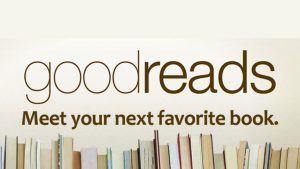
On goodreads.com, “users can add books to their personal bookshelves, rate and review books, see what their friends and authors are reading, participate in discussion boards and groups on a variety of topics, and get suggestions for future reading choices based on their reviews of previously read books.” I first discovered goodreads last year when it was recommended to me by my AP Literature and Composition teacher who told me that if I was interested in putting my own writing online, that I could also make a goodreads account in order to look at other writers works, and to also comment on book reviews to allow my options to be public and spur some activity onto my page as well.
The landing page of the goodreads site immediately displays an image (pictured above) that grabs the users attention. The image depicts a row of books lining the bottom with simple text above them that reads: goodreads – Meet your New favorite book. To the right of the image is where the site prompts the user to create an account to continue. Below the images are more texts that prompt the reader into joining with phrases such as “Deciding what to read next?” and “What are Your Friends Reading?” in addition to a search bar, recommended books with images of their covers, and a category menu.
I believe these elements were chosen in order to display the simplicity of the site, but also appealing to the audience by showing all that the site has to offer. The first screen of goodreads implies that the primary intended audience is simply anyone who loves books and is looking for an outlet to find them, or comment about them, and prompts the user with questions in order to persuade them to join.
The website emphasizes the use of books, both in the images it portrays and the text, to display the users interests. After logging in, the user is taken to the home screen of the site where they can immediately see a white bar that includes the sites logo, a menu, a search button, and the notification and message bar. This simple flat design does not overwhelm the user with information, but still provides them with options in order to explore the page. All aspects are in close proximity and the contrast on the page emphasizes the simplistic aspects of the site which limits items to the home screen to recommendations, updates, a reading challenge, and ads. The organization is neat and is simple to navigate, showing users different screens and information for each page.
Goodreads is not a complicated site with many colors and factors to display it’s purpose. Instead, because goodreads is aimed towards an audience specifically interested in reading or discovering books, the site displays a more simple design to get their audience interested in their site or their books specifically. The pale beige tones emphasize the color of the books’ covers when searched, rather than distracting from them with a colorful background, and also encourages serenity within the page.
word count: 509 (whoops)
Work Cited:
Wikipedia. “Goodreads.” Wikipedia, Wikimedia Foundation, 26 Jan. 2018, en.wikipedia.org/wiki/Goodreads.
“Goodreads.” Goodreads, Goodreads, 2018, www.goodreads.com/.
BALL, CHERYL E., et al. WRITER/DESIGNER. BEDFORD BKS ST MARTINS, 2018.
